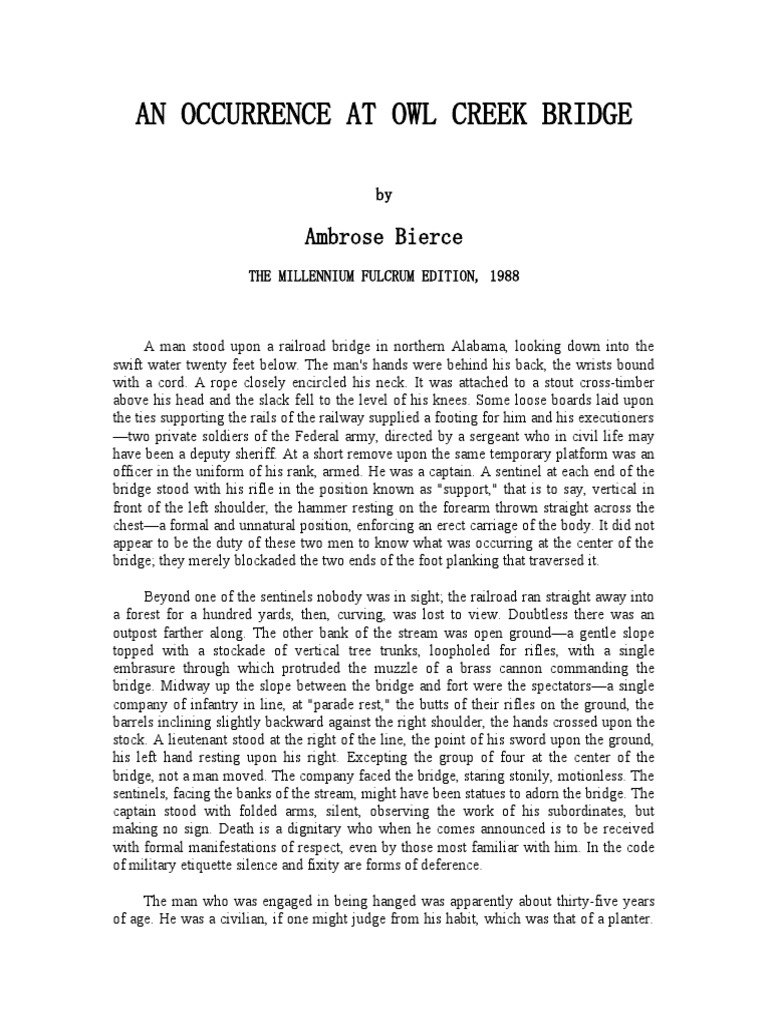Ambrose Bierce’s “An Occurrence at Owl Creek Bridge” remains a staple in American literature, frequently anthologized and analyzed. The story’s enduring appeal stems not just from its concise prose but also its exploration of time, perception, and the psychological refuge afforded by the human mind in the face of impending doom. It’s more than just a Civil War tale; it’s a meditation on the subjective nature of reality itself.
I. The Setup: War and Woe
The narrative commences with a stark tableau: Peyton Farquhar, a civilian and affluent plantation owner, stands on Owl Creek Bridge in Alabama, prepared for execution by hanging. Union soldiers surround him, their faces impassive. The precision of the military procedure contrasts sharply with the palpable tension that permeates the scene. We learn that Farquhar, though not a soldier, is a fervent supporter of the Confederacy, eager to contribute to the Southern cause. His social standing provides a crucial backdrop to his actions, suggesting motivations beyond simple patriotism.
II. A Deceptive Encounter: The Entrapment
A flashback elucidates Farquhar’s predicament. He encounters a Federal scout, disguised as a Confederate soldier. The scout informs him of the vulnerability of Owl Creek Bridge, suggesting it as a target for sabotage. Farquhar, blinded by zeal, takes the bait. The scout details the ease with which the bridge could be set ablaze, knowing full well he is planting the seeds of Farquhar’s destruction. This interaction underscores the insidious nature of espionage and the psychological manipulation inherent in warfare.
III. The Escape: A Distortion of Time and Reality
The hanging commences, and here the narrative takes a dramatic turn. The rope snaps, or so it seems. Farquhar plunges into the creek, seemingly evading the soldiers’ bullets. He unties his hands, removes the noose, and dives deep to avoid being shot. The description of his escape is vividly detailed, almost surreal. He perceives the sounds of the bullets with excruciating clarity; the passage of time seems to slow to a crawl. This hyper-awareness marks the beginning of his hallucinatory experience. He journeys downstream, avoiding capture, and begins his arduous trek home.
IV. The Homeward Journey: A Fantastical Odyssey
Farquhar’s imagined journey is filled with both beauty and peril. He navigates the wilderness, propelled by the unwavering desire to return to his wife and family. He encounters breathtaking natural landscapes – forests teeming with life, celestial vistas painted across the night sky. However, these idyllic scenes are punctuated by moments of terror. He experiences extreme physical discomfort, encountering obstacles both real and imagined. The sounds of the forest become menacing, and the stars seem to mock his desperate quest. This juxtaposition of beauty and terror highlights the precarious nature of his fabricated reality.
V. The Reunion: An Ironic Climax
After what seems like an eternity, Farquhar reaches his home. He sees his wife standing on the porch, radiant and welcoming. He rushes towards her, arms outstretched, eager to embrace her. This moment of anticipated joy is abruptly shattered. Just as his hands are about to touch her, he feels an excruciating pain in his neck. The narrative abruptly cuts back to the Owl Creek Bridge. Farquhar is still hanging, the entire escape sequence revealed to be a fleeting hallucination experienced in the moments between the drop and death.
VI. The Significance of Subjective Time
The brilliance of Bierce’s story lies in its manipulation of time. What seems like a protracted escape unfolds in mere seconds. The story demonstrates the malleability of subjective experience, especially under extreme stress. It’s a powerful illustration of how the mind can construct elaborate narratives as a coping mechanism against the inevitability of death. The story begs the question: Is the imagined escape any less real to Farquhar than his actual execution?
VII. Exploring Psychological Escapism
“An Occurrence at Owl Creek Bridge” delves into the human capacity for psychological escapism. Farquhar’s elaborate fantasy is a testament to the mind’s ability to create an alternate reality, however fleeting, to alleviate suffering. This act of self-deception, while ultimately futile, offers a momentary reprieve from the harsh realities of war and death. The story invites us to consider the role of imagination in confronting existential dread.
VIII. War’s Detrimental Impact
Beyond its exploration of time and perception, the story critiques the romanticized notions of war. Farquhar’s eagerness to serve the Confederacy, fueled by idealistic fervor, leads to his demise. The story exposes the brutality and dehumanization inherent in armed conflict, stripping away any semblance of glory or heroism. It’s a stark reminder of the devastating consequences of political ideologies and the willingness to sacrifice individual lives for abstract causes.
IX. The Unreliable Narrator and Reader Engagement
Bierce masterfully employs the technique of the unreliable narrator. The reader, initially led to believe in the plausibility of Farquhar’s escape, is ultimately confronted with the stark truth. This narrative deception forces the reader to actively engage with the text, questioning their own assumptions and interpretations. The story’s impact is amplified by this element of surprise, leaving a lasting impression on the reader’s mind.
X. Enduring Legacy and Modern Relevance
“An Occurrence at Owl Creek Bridge” continues to resonate with readers today because it tackles universal themes: the fear of death, the power of the human mind, and the devastating consequences of war. Its innovative narrative structure and psychological depth make it a timeless classic, deserving of continued study and appreciation. The story’s exploration of subjective reality remains profoundly relevant in a world increasingly shaped by virtual experiences and alternative narratives.
